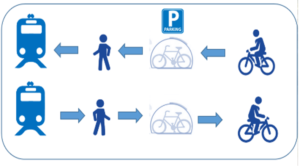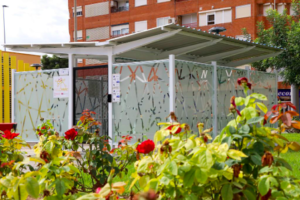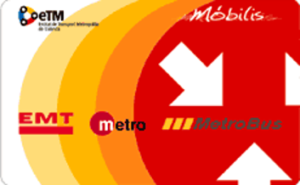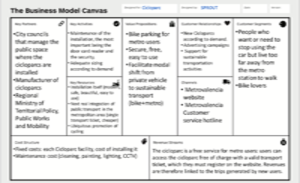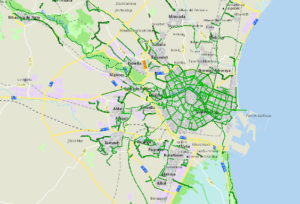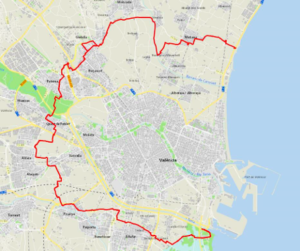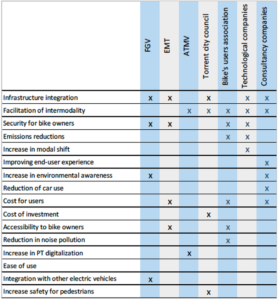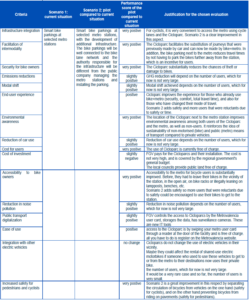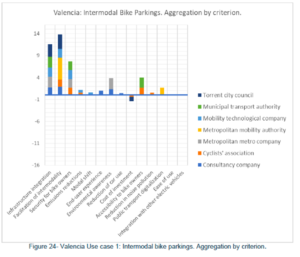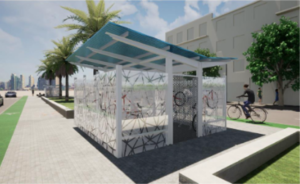Description
This text is a shortened and supplemented version of SPROUT D4.3: Impact assessment and city-specific policy response. Valencia Pilot.
The facilitation of intermodal mobility was at the core of the SPROUT Pilot in Valencia. The pilot assessed whether the provision of safe parking facilities at metro stations (Cicloparc) encourages a modal shift from private car use towards the combined use of private bicycles and public transport. The target group are commuters living at a medium distance from the metro station.
The solution consists of a parking system for private bicycles that was initially installed in two metro stations in the metropolitan area of Valencia. The bicycle parking facilities were designed by the metro operator (Ferrocarrils de la Generalitat Valencia, FGV) with the support of the Fundacion Valenciaport. The main design criteria were to guarantee security (avoiding theft and damage to private bicycles) and aesthetic criteria, as it would form part of the urban furniture of the city in which it was to be implemented and harmony with the urban landscape had to be guaranteed. In addition, a technological development was carried out to allow metro users to register their transport pass cards and with these same cards open the door to park their bikes. This area has also been equipped with surveillance cameras.
All owners of a valid public transport ticket can use the bike parkings. Access to the facilities requires a Metrovalencia travel card with an active public transport ticket. The travel card must be registered on the website www.metrovalencia.es before.
After activating the card and once in the Cicloparc, bike owners can use their card to open the gate with the reader that is installed in the entrance of the parking facility. When the card is swiped through the door reader, both the user number and the opening time remain registered in the Metrovalencia database. On their way back, users can pick up their bicycle using the same process, swiping their Metro card in the reader at the entrance and unlocking the bicycle by opening their own padlock.
Using the parking facilities is free of charge and time of use is limited to 24 hours.
Demonstration area were selected based on analysing passengers’ flows (most crowded nodes), a field study to analyse the availability of space, and security installatoins), and an on-line questionnaires to metro users
Empalme station is an interchange station for Metrovalencia Lines 1, 2 and 4. It is located in the municipality of Burjassot (more than 37,500 inhabitants), next to Valencia. It is also located near the CV-35 highway that connects Valencia with Ademuz. Torrent Avinguda station is an interchange station for Metrovalencia Lines 2 and 7. It is located in Avenida El Vedat, in the municipality of Torrent with more than 80,000 inhabitants.
The pilot is designed to support the current policies of Valencia City Council and the regional government (Generalitat Valenciana), encouraging the use of bicycles, public transport and intermodal mobility as an alternative to using private motor vehicles.
The city of Valencia is promoting a change in citizens’ mobility behaviour, focusing on mobility policies towards more environmentally friendly modes of transport. For example, the city’s cycle network has been extended by more than 75% in previous years, reaching a total length of 145 km by 2018, while improving the interconnection between the cycle lanes of the different areas and developing a cycle ring in the city centre.
The Metropolitan Area of Valencia passed the Basic Mobility Plan in July 2018. The plan contains an action line “intermodality as a priority in metropolitan mobility”, envisaging the development of a network of bicycle parking facilities at public transport stops. It proposes to install 21 safe bicycle parking facilities at suburban stations and 35 at metropolitan metro stops.
The SPROUT pilot is aligned with and contributes to achieving this target. In this sense, SPROUT facilitated a pilot case to derive knowledge on the success factors for the implementation of safe parking facilities throughout the Metropolitan metro network. The practical experiences and the SPROUT policy recommendations will feed into a strategy for the replication of safe parking facilities throughout the metropolitan area.
The following table provides an overwiew of the selected indicators, relevant data, and collection methods for the assessment of the pilot:
| Indicator | Data required | Data Collection |
|---|---|---|
| Financial assessment | ||
| Cost-covering price of parking (without additional revenues from potential new users of public transport) | Construction cost per parking facility | Ex-ante estimations |
| Maintenance cost per day | Ex-ante estimations | |
| Number of users per day | Via number of door openings. Automated data collection. | |
| For the current occupancy values of 3 or 4 users, the cost of the Cicloparc to be added to the ticket would be €2.19 and €1.64 respectively, for the two demo sites. | ||
| Sustainable impact assessment | ||
| Emission savings through changes of modal patterns | Replaced modes of transport | User survey: users and potential users. Online and on-place. |
| Number of users per day | Via number of door openings. Automated data collection. | |
| Length of average car trip | Assumption: 4km | |
| Number of replaced car trips | Assumptions: 2 / workday | |
| Average emission factor for private car | Assumption 0.174kg CO2/km | |
| Results: Based on the current use of Cicloparc (an average of 4 users), a saving of 0.7% of CO2 emissions is achieved. Assuming an average car park occupancy of 75%, which would mean 12 daily users of Cicloparc, the CO2 savings would rise to 2.8%. | ||
| Operational feasibility analysis | ||
| User acceptance | Number of users per day | Via number of door openings. Automated data collection. |
| User experience and suggestions | Interviews and survey. Online and on-place. | |
| Incidents | Number of incidences (technical) | Counting |
| Number of incidences (vandalism, theft) | Counting | |
| Out-of-service days due to incidences | Counting | |
| Transferability / replicability | Number of similar stations constructed in metropolitan area | Counting |
|
Results: Cicloparcs showed different degrees of success: The Torrent Avinguda site had an average occupancy of 2 daily users although it is rising and in October 2021 several days there have been 3 users. The maximum has been 4 users per day. Cicloparc of Empalme (included in SPROUT) has not had any success. There is only one user, and not every day. Users tend to leave their bicycles early in the morning and pick them up in the afternoon, some before 18h and others after. The use of Cicloparcs, however, is not completely linked to commuting to work. This is detected by the duration of parking. 4 incidences during the first week of implementation of the Cicloparc, some errors detecting the cards for opening. One small fire in one of the station's manholes affected several services and equipment, the station was out of service during two days. No bikes were stolen from a Cicloparc during the pilot phase. The Cicloparc model was installed at two initial metro stations (Empalme and Torrent Avinguda) and it was transfer to other 2 in the metropolitan area of Valencia (Alboraya-Palmaret and Quart) and 1 in other city on Valencia Region, Benidorm Station in Alacant city. |
||
The formulation of policy responses follows a Stakeholder-Based Impact Scoring (SIS) approach. The following paragraphs outline the results and findings form applying this method to the Cicloparc pilot in Valencia.
Practical information on the SIS approach is provided under the toolbox section Analysis Phase and Policy Responses
The first step in the SIS approach is the identification of problems that cities have encountered during the implementations and potential policy responses to address these challenges.
Focal point of the identified challenges was the use and the management of public land and infrastructures that are beyond the control of the public transport operator, including:
- Lack of space inside the metro station to install bike parking facilities. The facilities need to be located on public land that belongs to the municipality and managed by the corresponding city hall.
- Connection to bike infrastructure: Bike parkings should be connected to the local and the inter-municipal cycling network. These infrastructures are not managed or developed by the public transport operator.
- The cycling network in the municipal area is managed at different levels, not always as coordinated as would be desirable: The Metropolitan Green Ring bike lane is developed by the regional government, while the cycling networks in the municipalities are managed by the respective jurisdictions. Together these infrastructures form an extensive cycling network in the municipal area.
Moreover, stakeholders emphasized the need for high commitment from local and regional authorities to have a cycling strategy in their mobility plans, to have regulations involving the safety of bicyclists and pedestrians and to focus on the security of users.
The following solutions were suggested to deal with those problems:
- Development of infrastructures needed (for instance the bike parkings installed at metro station should be well-connected to the bike lane network)
- Establishing collaboration mechanisms between public entities with different competences but common objectives towards more sustainable mobility and urban logistic, through:
- Memorandums of understanding
- Working groups
- Common roadmaps
- Agreements between municipalities in the region to collaborate in the implementation of sustainable mobility measures. These agreements would contain:
- Sharing information to co-create new mobility services
- Regulations to facilitate the installation of mobility services promoted by public entities
- Cost-free access to public land for sustainable mobility purposes
- Definition of responsibilities of each public authority (maintenance, insurances, surveillance, cleaning…)
For subsequent stages, the pilot project in combination with the proposed policy solutions will be referred to as alternative pilot.
Policy recommendations were derived building on the knowledge and the preferences of key stakeholder groups. The following groups have been selected:
Research centers and technological companies
- Fundación Valenciaport
- Mobility technology company
- Consultancy company
Public bodies
- Valencian Regional Government
- Valencia City Council
- Torrente City Council
Public transport
- Ferrocarrils de la Generalitat Valencia, FGV, a public company under the regional government
- Empresa Municipal de Transportes de València, EMT
- Autoritat de Transport Metropolità de Valencia, ATMV
Users and civil society associations
- Local bike association
- Individual users
Practical information on the selection of stakeholders can be found in the section “Co-creating and utilizing scenarios” and in the SPROUT catalogue of urban mobility stakeholders
The key question for the formulation of criteria is the following: what distinguishes a good project alternative from a bad one? Stakeholders therefore reflect on what their objectives are with the implementation of a project. These criteria can be both positive and negative, and examples include traffic safety, cost, or accessibility.
The following table indicates the criteria that were identified by the stakeholder groups:
In a later stage, stakeholders were asked to indicate the importance of the collected criteria for a successful project implementation. This weighting shows the relative importance that the stakeholders attach to each criterion.
In the next step, stakeholder criteria were brought together with the policy solutions identified in step 1. Aim was to understand, whether the alternative pilot (step 1) reflects stakeholder criteria to a higher or to a lower degree than the original pilot without additional interventions. SPROUT research partners assessed the effects of the alternative pilot with policy implementation compared to the pilot without policy changes for each of the stakeholder criteria. The alternative is given a performance score on a 7-point scale, ranging from ‘Very negative’ to ‘Very positive’.
Results showed that almost all criteria were affected in a positive way. Only “integration with other electric vehicles” remained unchanged; and “cost of investment” received a slightly negative score.
While the current situation (smart bike parkings at selected metro stations) was taken as baseline, the alternative pilot involves the development of additional infrastructure (the bike parkings will be well connected to the bike lane network) and agreements among public authorities responsible for public land and infrastructures.
A facilitated intermodality, infrastructure integration and security for bike owners were found to be the most important potential positive impacts. ‘Cost of investment’ is the only negative impact, but its effect is expected to be relatively minor.
Almost all actors expect positive impacts on their relevance criteria. The only expected negative impact, ‘cost of investments’ is relevant for the Torrent City Council (construction costs of cycling infrastructure and parking facilities) and to a lesser degree to the cyclists’ association.
Compared to the pilot as it is, the development of additional infrastructure such as a good connection of the parkings to the bike lane network, as well as different authorities being responsible for the infrastructure and for the management of the metro station, has positive effects on all stakeholders. The only negative effect is felt by the Torrent city council and the Cyclists’ association in terms of ‘costs of investment’. The mobility technology company is expected to feel the most positive impact, although the difference with the other stakeholders is relatively small. The most important criteria, across all stakeholders, are the facilitation of intermodality, infrastructure integration and security for bike owners.
Buidling on the previous steps, SPROUT partners derived a list of policy responses, based on the SPROUT policy inventory. The following policy measures have been sugested:
- Establishment of low emission zones
- Building protected and well-maintained bike lanes
- Improvement of existing bike network by connecting with interurban bike lanes as well as with urban intermodal modes
- Sustainable public transport: subsidies and promotional campaigns
The suggested policy measures were then assessed through stakeholders, using the Recommended Indicators for Assessing Policy Implementation Feasibility and User Acceptance of New Mobility Solutions
In order to support intermodal mobility, stakeholders from Valencia prioritised measures to enhance and to extend the cycling network as priority policy responses. This includes the construction of safe, protected and well-maintained bike lanes, but also the linkage of existing bike infrastructure to intermodal nodes and the interurban bike network. Moreover, stakeholders suggested to provide incentives for potential users and to carry out promotional campaigns to increase awareness on the mobility solution.
Moreover, stakeholders identified a need to enhance coordination and collaboration among the relevant departments of the city administration, but also with the public transport operator and with neighbouring communities in the metropolitan area, where the pilot parking facilities are located. Responsibilities of public authorities (e.g., for maintenance, surveillance, regular cleaning) needed to be clearly assigned. Accordingly, stakeholders emphasized the importance of clear guidelines in the Metropolitan Mobility Plan, in order to facilitate the construction, provision, and operation of safe bike parking facilities at metro stations.
This step resulted in the following measure package as policy response:
- “Building protected and well-maintained bike lanes” although the cost is high, the indirect benefits make it a priority for public agents who may not agree on the provision of this measure. Therefore, Valencia may need to improve the coordination between the different departments and the Publication of the Metropolitan Mobility Plan and the plan’s implementing regulation.
- “Improvement of existing bike network by connecting with interurban bike lanes as well as with urban intermodal modes”. The main differences to the first measure was that this measure was considered as more expensive, and to raise safety there is a greater need to increase citizens’ knowledge and awareness and improve the application of punitive measures.
- Both infrastructure measures require increased collaboration and coordination between the different public departments.
- “Subsidies and promotional campaigns for sustainable public transport”, was considered as the most supportive measure to enhance the adoption of the Cicloparc. The stakeholders participating in the pilot deemed that “There is a clear need to improve information to users and all citizens”, and it requires more internal institutional support to convey information to potential users. With more support from institutional bodies, this measure may increase the number of commuters that leave the car in favour of the intermodal combination of micomobility and public transport.
- Another incentive is that using the parking facilities is cost-free for public transport users, arguing that a cost-covering fee would have deterred potential users. The decision to waive user fees was justified through the broader socio-economic benefits that intermodal mobility has (see the section on Financial and sustainability assessment of the pilot’s impacts above).
Key learnings and recommmendations
The following key messages were derived from the pilot:
- Public-private agreements to cede public space to private companies requires anticipated planning of the negotiation process between logistics operators and intermodal hub managers, including data sharing clauses.
- Good coordination is essential when working with different public administration institutions and departments.
- Promote and diseminate the new mobility solutions to increase visibility among the potential users and attract non-users.
- Selection of location candidates should be based on traffic data, technical specifities and users’ preferences.
- Do not stop providing new value propositions to increase the awareness and willingness to shift from private cars to public transport, shared services and micromobility modes (metro maps to include the locations where these services are available).
SPROUT materials and tools
Further Information
More information on intermodality on metrovalencia’s website: https://www.metrovalencia.es/en/intermodality/

